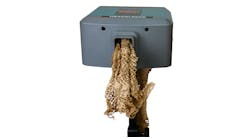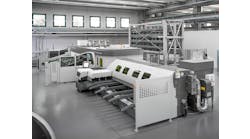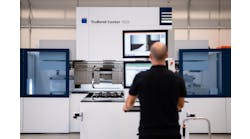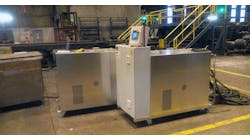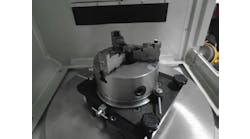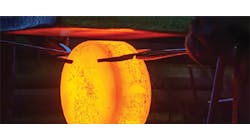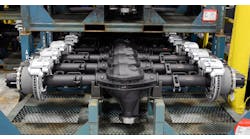... We aim to produce a 304 stainless steel eye forging on a 6,000-lb Chambersburg drop hammer. The part has a diameter of 2.375 in. and weighs 3.8 lb. It will be forged two to a platter in the following sequence: edge, bust, block, and finish. The part has a piercing diameter of 3.0 in. and a flange diameter of 4.5 in. The impression depth in each die is 2.25 in. The part will be transferred onto the hammer after reduction rolling for the tong hold.(Our greatest limitation is that we do not have a standby furnace to reheat the parts if they should not finish within finishing temperature.)
A: What you describe can be a tricky job. Compared to alloy steel, 304 stainless is much tougher, and requires 2.5 to 4 times more impact force to forge than, say, 1040 steel. It can be forged at temperatures up to 2,250°F after it is well-soaked through, so long as it is forged with good reductions. It has been forged as high as 2,300°F, but in presses, not hammers, due to the heat build-up on the forging in hammers.
The forging of a tong hold is going to be tricky without losing a lot of heat. If this is a pigeon hole heater, you can reheat the larger end after rolling a tong hold. If it is a continuous channel or solenoid coil, then it must be forged in one heating as you suggested.
Without spending a lot of time in estimating the plan view area of the blocker and finisher forging, I suggest that you may have to do one of the following:
• Use forging dies that have been opened up at the flash land by 20-30% over a die for forging a carbon steel eye of the same size; Or,
• Go up another hammer size, if you have it.
It would be a good practice to forge a steel billet first to get a handle on how to manipulate the pieces, and to warm up the dies before forging stainless steel.
For more than 40 years H. James Henning held key technical positions in the forging industry, including as director of technology for the Forging Industry Association, and as president of Henning Education Services, a Columbus, OH, firm specializing in customized education and training in forging technologies.
Guidelines and recommendations offered in this column are based on information believed to be reliable and are supplied in good faith but without guarantee. Operational conditions that exist in individual plants and facilities vary widely. Users of this information should adapt it, and always exercise independent discretion in establishing plant or facility operating practice.
